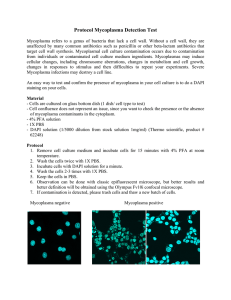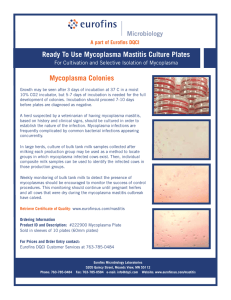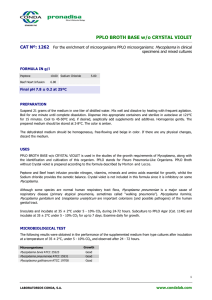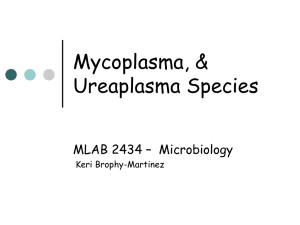Mycoplasma – Often Overlooked In Chronic Lyme Disease‐infected
advertisement
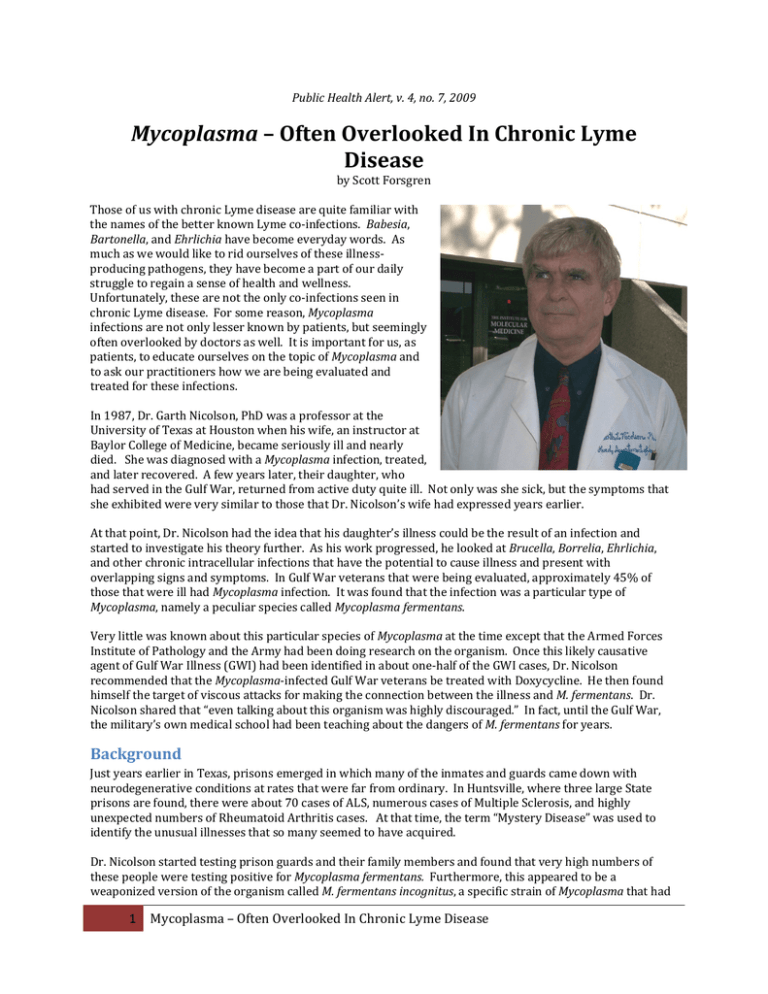
Public Health Alert, v. 4, no. 7, 2009 Mycoplasma – Often Overlooked In Chronic Lyme Disease by Scott Forsgren Those of us with chronic Lyme disease are quite familiar with the names of the better known Lyme co‐infections. Babesia, Bartonella, and Ehrlichia have become everyday words. As much as we would like to rid ourselves of these illness‐ producing pathogens, they have become a part of our daily struggle to regain a sense of health and wellness. Unfortunately, these are not the only co‐infections seen in chronic Lyme disease. For some reason, Mycoplasma infections are not only lesser known by patients, but seemingly often overlooked by doctors as well. It is important for us, as patients, to educate ourselves on the topic of Mycoplasma and to ask our practitioners how we are being evaluated and treated for these infections. In 1987, Dr. Garth Nicolson, PhD was a professor at the University of Texas at Houston when his wife, an instructor at Baylor College of Medicine, became seriously ill and nearly died. She was diagnosed with a Mycoplasma infection, treated, and later recovered. A few years later, their daughter, who had served in the Gulf War, returned from active duty quite ill. Not only was she sick, but the symptoms that she exhibited were very similar to those that Dr. Nicolson’s wife had expressed years earlier. At that point, Dr. Nicolson had the idea that his daughter’s illness could be the result of an infection and started to investigate his theory further. As his work progressed, he looked at Brucella, Borrelia, Ehrlichia, and other chronic intracellular infections that have the potential to cause illness and present with overlapping signs and symptoms. In Gulf War veterans that were being evaluated, approximately 45% of those that were ill had Mycoplasma infection. It was found that the infection was a particular type of Mycoplasma, namely a peculiar species called Mycoplasma fermentans. Very little was known about this particular species of Mycoplasma at the time except that the Armed Forces Institute of Pathology and the Army had been doing research on the organism. Once this likely causative agent of Gulf War Illness (GWI) had been identified in about one‐half of the GWI cases, Dr. Nicolson recommended that the Mycoplasma‐infected Gulf War veterans be treated with Doxycycline. He then found himself the target of viscous attacks for making the connection between the illness and M. fermentans. Dr. Nicolson shared that “even talking about this organism was highly discouraged.” In fact, until the Gulf War, the military’s own medical school had been teaching about the dangers of M. fermentans for years. Background Just years earlier in Texas, prisons emerged in which many of the inmates and guards came down with neurodegenerative conditions at rates that were far from ordinary. In Huntsville, where three large State prisons are found, there were about 70 cases of ALS, numerous cases of Multiple Sclerosis, and highly unexpected numbers of Rheumatoid Arthritis cases. At that time, the term “Mystery Disease” was used to identify the unusual illnesses that so many seemed to have acquired. Dr. Nicolson started testing prison guards and their family members and found that very high numbers of these people were testing positive for Mycoplasma fermentans. Furthermore, this appeared to be a weaponized version of the organism called M. fermentans incognitus, a specific strain of Mycoplasma that had 1 Mycoplasma – Often Overlooked In Chronic Lyme Disease been altered to cause more severe symptoms, to be more virulent, and to be more survivable than the naturally occurring M. fermentans. Dr. Nicolson believed that biological weapons experiments had been carried out on inmates in the Texas prison system for years in which humans had been used as guinea pigs. As time progressed, these illnesses did not remain confined to the prisoners. Soon after the prisoners unknowingly became a part in these experiments, the prison guards became ill. Their illnesses gradually became those of their families. It was not long before these Mycoplasma‐based illnesses became a broader part of the surrounding Huntsville, Texas landscape. The Texas prisoners that came down with Amyotrophic Lateral Sclerosis (ALS) later died. In the state of Texas at the time, the state law dictated that all prisoners that died were later to be autopsied at University of Texas at Galveston. However, that was not what was happening to the prisoners who had died as a result of this horrific experimentation according to Dr. Nicolson. Through one of his former students who at the time was responsible for the autopsy service at UT Galveston, Dr. Nicolson learned that none of the bodies had been sent there. Dr. Nicolson had discovered that at least six private autopsies a week were being performed on deceased prisoners at a US Army base. The bodies were then sent to a private crematory at a secret location in central Texas. Additionally, prisoner records were destroyed. All of this, according to Dr. Nicolson, violated state law. Though much of the evidence of this experimentation had been destroyed, a document was found in the basement of an Austin building that was viewed as the “smoking gun”. The document indicated that the Texas Prison Board, Baylor College of Medicine, and the Department of Defense were all a part of the experiments involving the Texas prisoners ‐ experiments that later resulted in the death of many of the inmates. According to Dr. Nicolson, some of the experiments used Mycoplasma while others utilized various “cocktails of microbial agents” such as Mycoplasma, Brucella, and DNA viruses such as Parvovirus B19. This project later become the topic of a book by Dr. Nicolson entitled Project Day Lily. Dr. Nicolson believes that Mycoplasma fermentans is a naturally occurring microbe. However, some of the strains that exist today have been weaponized. Dr. Nicolson’s research found unusual genes in M. fermentans incognitus that were consistent with a weaponized form of the organism. Weaponzing of an organism is done in an attempt to make a germ more pathogenic, immunosuppressive, resistant to heat and dryness, and to increase its survival rate such that the germ could be used in various types of weapons. Genes which were part of the HIV‐1 envelope gene were found in these Mycoplasma. This means that the infection may not give someone HIV, but that it may result in some of the debilitating symptoms of the HIV disease. Indicators of a weaponized organism were evident in the prison guards in Huntsville as well as in military personnel that were likely exposed to the infections both through military vaccinations as well as through weapons used in the Gulf War. Mycoplasma is the number one coinfection observed in Lyme disease patients The unfortunate reality according to Dr. Nicolson is that “once these things get out, you can’t put the genie back in the bottle”. Once these germs have been released, they are airborne infections that slowly penetrate into the population. In the case of Mycoplasma fermentans, Dr. Nicolson believes that this is exactly what happened. It may be this weaponized form of Mycoplasma that has led to the significant increases in neurodegenerative and autoimmune diseases over the last several years. Those patients with weaponized strains of these organisms are generally very sick. They may experience 60‐75 signs and symptoms and are even at risk of their diseases becoming fatal. In looking at the source of infection in the Gulf War veterans who were contracting Mycoplasma, Dr. Nicolson suggests that vaccinations appear to be the most likely mechanism through which the veterans became infected. Many military personnel that later became ill were far from the battlefields or had received the vaccinations and were never deployed. However, biological weapons sprayers were known to have been deployed by the Iraqis in the Gulf War and were used to spray the sand in Iraq and Kuwait. Gerald 2 Mycoplasma – Often Overlooked In Chronic Lyme Disease Schumacher, a Special Forces colonel in charge of biological weapons detection, blew the whistle on this after he retired. During the Gulf War, his group was not allowed to deploy their biological weapons detectors which led to reports that no such weapons were detected or used. The Iraqis received a great deal of assistance on biological warfare from the United States during the Iran‐ Iraq Conflict. Both chemical and biologic weapons were given to them from the United States. After the Gulf War, rather than taking inventory of these weapons, they were blown up. Dr. Nicolson indicates that some of his patients have taken videos standing next to crates with Hazardous Materials tags from the United States. In the same videos, the crates are opened and weapons are clearly striped as having originated from the United States and being both chemical and biological weapons. There were clear indicators that Iraq had offensive weapons in their arsenal. In Kuwait, many people had become quite ill. It was estimated that 25% of the population after the Gulf War had signs and symptoms which matched the symptoms of those infected with weaponized Mycoplasma. There were also a number of other chemical exposures and thus, there was never a clear indicator as to whether or not the Iraqi illnesses were caused by biologic or chemical agents. When asking Dr. Nicolson how much he personally has been harassed for bringing much of this information to light, he shared that it has been “a horrific time”. After Dr. Nicolson exposed the Huntsville prison experiments, the University of Texas educational system attempted to fire him from his tenured and highly respected position. Dr. Nicolson shared that a tremendous amount of pressure was put on the University of Texas system to “shut him up and close his laboratory”. He was threatened on an almost daily basis with closing his lab as he continued to do his research on Mycoplasma. This became a major subject in the book Project Day Lily. Fortunately, for many of us struggling with chronic illnesses, Dr. Nicolson’s experience and knowledge continue to be a benefit in that we understand so much more than we otherwise would about this formidable foe called Mycoplasma. Symptoms The signs and symptoms of Mycoplasma infection are highly variable and thus it is not uncommon for a diagnosis to be entirely missed. A partial list of symptoms includes chronic fatigue, joint pain, intermittent fevers, headaches, coughing, nausea, gastrointestinal problems, diarrhea, visual disturbances, memory loss, sleep disturbances, skin rashes, joint stiffness, depression, irritability, congestion, night sweats, loss of concentration, muscle spasms, nervousness, anxiety, chest pain, breathing irregularities, balance problems, light sensitivity, hair loss, problems with urination, congestive heart failure, blood pressure abnormalities, lymph node pain, chemical sensitivities, persistent coughing, eye pain, floaters in the eyes, and many others. On Dr. Nicolson’s web site at http://www.immed.org, a full list of signs and symptoms and an illness survey form can be found. It doesn’t take long to see that the symptoms of Mycoplasma infections are very similar to the symptoms of Borrelia infections in chronic Lyme disease. Dr. Nicolson has looked at some of the more common neurodegenerative diseases and the infections that are associated with each. Mycoplasma is commonly found in patients with ALS, Multiple Sclerosis, Autism, Chronic Fatigue Syndrome, Rheumatoid Arthritis, Chronic Asthma, Lyme disease, and many other chronic disease conditions. Illness Amyotrophic Lateral Sclerosis (ALS) Multiple Sclerosis (MS) Alzheimer’s Disease Parkinson’s Disease Autism Spectrum Disorders Chronic Fatigue Syndrome Infections Commonly Observed Mycoplasma fermentans (and other species), Borrelia burgdorferi, HHV6, Chlamydia pneumoniae Chlamydia pneumoniae, Mycoplasma species, Borrelia burgdorferi, HHV6 and other Herpes viruses Chlamydia pneumoniae, Borrelia burgdorferi, HSV1 and other Herpes viruses Helicobacter pylori, coronavirus, Mycoplasma species Mycoplasma fermentans (and other species), Chlamydia pneumoniae, HHV6, Borrelia burgdorferi Mycoplasma pneumoniae (and other species), Chlamydia pneumoniae, 3 Mycoplasma – Often Overlooked In Chronic Lyme Disease Lyme Disease Borrelia burgdorferi Borrelia burgdorferi, Mycoplasma fermentans (and other species), Babesia species, Bartonella species, Ehrlichia species Chronic illnesses and infections commonly observed in each according to the work of Dr. Garth Nicolson, PhD Characteristics Mycoplasma are pleomorphic bacteria which lack a cell wall and as a result, many antibiotics are not effective against this type of bacteria. There are over 100 known species of Mycoplasma, but only a half dozen or so are known to be pathogenic in humans. The pathogenic species are intracellular and must enter cells to survive. Once they are inside the cells, they are not recognized by the immune system and it is difficult to mount an effective response. They stimulate reactive‐oxygen species (ROS) which damage cell membranes. They release toxins into the body. Infected cells can be stimulated to undergo programmed cell death which may result in ALS or other severe neurological presentations. 90% of ALS patients evaluated were found to have Mycoplasma infections, whereas Mycoplasma was found in 100% of ALS patients with Gulf War Syndrome, almost all of which were weaponized M. fermentans incognitus. They are thought of as “borderline anaerobes” meaning that they generally prefer low oxygen environments. Dr. Nicolson has found that airline employees are much more susceptible to these types of infections and that symptoms worsen with frequent long flights at low oxygen tension. Mycoplasma also have some characteristics of viruses. Mycoplasma tend to be slow growing infections and they are usually transmitted slowly. Dr. Nicolson states that “Mycoplasma can be sexually transmitted, but the infection is usually passed through far less intimate contact. Mycoplasma can be obtained through fluid exchange, and it is easily transmitted through the air.” In Gulf War veterans, the first person besides the veteran to become ill was the spouse and later, other members of the household also became ill. Not everyone is equally susceptible to Mycoplasma infections, especially those with strong immune systems who can resist infection. As already discussed, Mycoplasma fermentans produces numerous symptoms. Those infected are rarely found to be asymptomatic. In North America, M. pneumoniae is the most common Mycoplasma seen in various diseases. In Europe, M. hominis is far more prevalent and the incidence of M. fermentans is much lower than in North America. The potential genetic factors involved in Mycoplasma illnesses are not known. Those with immune deficiencies and other illnesses, such as cancers and degenerative diseases, are at far greater risk of infection. Prevalence In one study looking at Mycoplasma in patients with Chronic Fatigue Syndrome, Dr. Nicolson has observed some interesting patterns in his research. Generally, the majority of CFS patients have Mycoplasma infections. However, CFS patients infected with Borrelia burgdorferi, the punitive agent in Lyme disease, had an even higher overall Mycoplasma infection rate. As many as 75% of Lyme disease patients appear to have Mycoplasma infections, and yet Mycoplasma is often overlooked in the diagnosis and treatment of chronic Lyme disease, neurodegenerative diseases, and many other chronic illnesses lacking clear origins. Even more startling was the finding that of that of the patients infected with Borrelia, over 50% of the patients had the M. fermentans infection. Approximately 23% carried M. pneumoniae. Chronic Fatigue patients that did not test positive for Borrelia had much more of a mixture of various species of Mycoplasma. Only 28% of the group not co‐infected with Lyme disease had the M. fermentans infection. In normal, healthy controls, only 1.7% were found to have M. fermentans and at a total Mycoplasma infection rate of 5% compared to the 75% group mentioned earlier. 4 Mycoplasma – Often Overlooked In Chronic Lyme Disease Dr. Nicolson notes that these findings are consistent with the fact that it is the Mycoplasma fermentans species that is more often isolated in ticks collected from the environment. The same tick that serves as the vector for Borrelia burgdorferi often also transmits M. fermentans simultaneously. Once a patient is multiply co‐ infected, the duration and severity of their illness both increase. In his experience, Dr. Nicolson has found that Mycoplasma is the number one Lyme coinfection. The rate of infection with Mycoplasma in patients with Lyme disease surpasses that of Bartonella (25‐40%) slightly and that of Babesia (8‐20%) significantly. According to Dr. Nicolson, a healthy immune system can generally clear M. pneumoniae infections though will have a harder time eradicating M. fermentans on its own. Healthy people can often hold these infections in check ‐ essentially having the infection but not expressing symptoms. Incidence of Various Microbes in Patients with Lyme Disease – G. L. Nicolson Testing Dr. Nicolson noted that Mycoplasma infections in chronic Lyme disease are often overlooked by most doctors because they simply don’t test for it. He states that those that do test for it find a much higher number of infected patients. Dr. Richard Horowitz, MD in New York finds a high incidence of M. fermentans according to Dr. Nicolson. Sadly, however, even if patients are tested for Mycoplasma, a similar problem exists here as the one that almost all Lyme doctors and patients are aware of – namely that reliable tests do not exist. Dr. Nicolson notes that once a laboratory gets a reliable test in place, the laboratory is often shutdown. There are only a few labs left that test for Mycoplasma as a result. In testing ticks for various microbial species, Dr. Nicolson has found a very high incidence of Mycoplasma fermentans. However, other Mycoplasma species have also been found such as M. pneumoniae and M. hominis. The incidence of these other species is far lower. “Far and away”, it is the M. fermentans species that is seen in ticks, and this probably reflects the high incidence of M. fermentans coinfections in Lyme disease. In terms of laboratory testing, Dr. Nicolson generally recommends Viral Immune Pathology, formerly known as RedLabs. He has found that the usefulness of any given lab in testing for Mycoplasma changes regularly. In the past, Dr. Nicolson used Medical Diagnostic Laboratories (MDL) for testing, but later he and other physicians found that the testing was no longer reliable. As a result, he no longer recommends MDL. Dr. Nicolson finds that laboratories testing for Mycoplasma are highly scrutinized by federal agencies and that may affect the way the labs test and report this type of infection. 5 Mycoplasma – Often Overlooked In Chronic Lyme Disease Autoimmunity Thomas McPherson Brown, MD studied Mycoplasma at the Rockefeller Institute just before World War II. He was able to isolate bacteria from the joint fluid of a person with autoimmune arthritis and believed that the infection could have been the trigger for her disease. At the time, the organisms were too small to identify precisely, but it was later determined to be Mycoplasma. Even then, Dr. Brown believed that Mycoplasma was very common and not easy to eradicate. He suggested using tetracycline drugs as an effective treatment for the disease. He later found that Doxycycline and Minocycline were effective at dealing with Mycoplasma. Though he garnered praise from his patients, he was generally regarded by the medical community as misguided and a trouble‐maker. He died in 1989 prior to being fully vindicated. Fortunately, his work was validated through an NIH‐sponsored study called MIRA or “Minocycline in Rheumatoid Arthritis”. Due to many of the characteristics of Mycoplasma, they may be responsible for the triggering of numerous autoimmune responses. As Mycoplasma replicate within cells and are eventually released, they capture antigens from the surface of the host cell and incorporate these antigens into their own membranes. This makes it almost impossible for the body to tell the difference between good and bad, between human and microbe, or between us and them. As a result, the immune system may begin to respond to these antigens now incorporated into the cell walls of the bacteria and create a condition of self‐attack, or autoimmunity. The microorganisms can produce mimicry antigens that mimic the natural host surface antigens and trigger an immune response to these antigens which may also result in autoimmune conditions through cross‐ reactivity. Additionally, Mycoplasma may cause cell death of host cells through a process known as apoptosis or programmed cell death. Treatment Though various strains of Mycoplasma have their own unique characteristics and drug responses, treatment tends to be quite similar. The variations in the strains do not appear to be a factor in a successful treatment response. Dr. Nicolson suggests that in­vitro differences have been found but that it is not possible to easily extrapolate these findings to an in­vivo environment. Various factors including drug targeting, drug clearance, and the ability for the drug to cross into various body compartments are important considerations in treatment that cannot be examined in­vitro. Dr. Nicolson believes that, like many other coinfections of Lyme disease, Mycoplasma cannot be fully eradicated, but that once infected, treatment becomes an ongoing “management approach”. He notes that this is a commonly understood fact and that the same is true of other organisms such as Chlamydia and Borrelia. Mycoplasma have the ability to go into a quiescent phase in intracellular locations within the body. Once in these locations, neither antibiotics nor the immune system can effectively reach or kill the organisms. Many people recover from Mycoplasma infections and are fine for years. They may later have an incident involving severe trauma or other significant life stressor and symptoms fully reappear within weeks to months. Dr. Nicolson recommends that the physician adopt an initial 6‐month course of treatment with no break followed by several 6‐week on, 2‐week off antibiotic cycles. Candidate antibiotics include: Doxycycline, Ciprofloxacin (Cipro), Azithromycin (Zithromax), Minocycline, or Clarithromycin (Biaxin). He notes that antibiotic combinations may be required if there is a limited response to single drug, and most patients require switching antibiotics at least once during their treatment. Some patients may find the addition of Flagyl to be a benefit to treatment. 6 Mycoplasma – Often Overlooked In Chronic Lyme Disease In Gulf War patients, once effectively treated, the majority of patients recovered. For civilians, six months is the minimum recommended treatment length, and some patients require much longer treatment in order to recover. Given that Mycoplasma have some characteristics of viruses, some physicians have suggested that Famvir or Ganciclovir may be added to the antibiotic therapy. Herxheimer reactions do occur when treating Mycoplasma infections. To minimize this die‐off effect where the patient generally feels much worse while on treatment, Dr. Nicolson advises using 50mg oral Benadryl taken 30 minutes before the antibiotics. He also finds that a strained blend of 1 whole lemon, 1 cup fruit juice, and 1 tablespoon of olive oil can be helpful. Though Dr. Nicolson believes that antibiotics are the most effective approach to treating Mycoplasma infections, he has found some good natural options. In terms of natural approaches to treating Mycoplasma, Raintree Nutrition (http://www.rain‐tree.com) has created several products that may be quite helpful for patients. These include Raintree Myco, Raintree A‐F, and Raintree Immune Support. Dr. Nicolson has seen evidence that Mycoplasma‐specific transfer factors such as those from Chisholm Labs and others can be beneficial in some patients. He says that many natural options help in some patients, but that his experience has been that the antibiotic treatment results in the best outcomes. In many, recovery requires a push and pull between conventional and alternative treatments. None of these treatments are a panacea. It takes a combination of things to resolve a patient’s symptoms. One of the hallmark signs of Mycoplasma infection is fatigue. The infections lead to oxidation in the body that leads to damage of the cell membranes. Oxidation accelerates the damage to the lipids in cell membranes which impacts mitochondrial function. This leads to less energy in the cell and ultimately to a fatiguing of the larger organism due to the fact that there is less energy to support necessary cellular functions. In patients where fatigue is due to cell membrane damage, Dr. Nicolson has found NT Factor® to be highly beneficial. NT Factor® replaces the damaged lipids and helps to restore mitochondrial function. Often, fatigue then resolves or is reduced. Dr. Nicolson has found that oxidative therapies such as ozone can be helpful in the fight against Mycoplasma. However, he notes that this is generally palliative and does not produce the same results as the antibiotic therapy in the long‐term. He finds that the oxidative therapies “are generally more cytostatic than cytotoxic”. Hyperbaric oxygen may be helpful but similarly does not appear to be a highly effective treatment in the longer‐term. In other countries, IV drips with H2O2 (hydrogen peroxide) have been used with some benefit, but Dr. Nicolson notes that these therapies, while potentially effective, are highly dangerous and not advised. In the realm of frequency medicine and Rife therapy, Dr. Nicolson believes that the frequencies that could be used to address Mycoplasma are too similar to normal cellular frequencies. Thus, he is not certain that Rife therapy is an effective way to approach the problem. In the nutritional realm, Dr. Nicolson finds that many patients with chronic infections are immunosuppressed and that proper nutrition is vital. He cautions against smoking and drinking. He suggests avoidance of sugars trans‐fats, and allergenic foods. He advises patients to increase their fruits, vegetables, and whole grains. Some dietary winners in supporting the immune system include cruciferous vegetables, soluble fiber‐based foods such as prunes and bran, wheat germ, yogurt, fish, and whole grains. 7 Mycoplasma – Often Overlooked In Chronic Lyme Disease Patients are often depleted in key vitamins and minerals. Supplementation with B‐Complex, Vitamin C, Vitamin E, and CoQ‐10 are often beneficial. Minerals are often necessary. Dr. Nicolson notes, however, that many people have poor absorption and may require sublingual or injectable forms of these nutrients. Amino acids, flax seed, and fish oils can provide additional support, but the best nutrition for cell membranes is NT Factor®. Many patients with chronic illnesses have a toxic body burden of heavy metals such as mercury, lead, cadmium, and aluminum. Hair, stool, and urine testing is available through labs like Doctor’s Data (http://www.doctorsdata.com) and Genova Diagnostics (http://www.gdx.net). Dr. Nicolson has seen reports of positive results with EDTA chelation suppositories from Detoxamin (http://www.detoxamin.com) and oral chelators from Longevity Plus (http://www.longevityplus.com). For patients using antibiotics, beneficial gut flora is often depressed. Supplementation with a high quality probiotic is important, but probiotics have to be taken two hours or longer after taking antibiotics. Natural immune support can be helpful in the form of whey proteins, transfer factors, or immune‐support products such as Beyond Immuni‐T from Longevity Plus. Biolfims Dr. Nicolson believes that biofilms are a factor in successfully treating Mycoplasma infections. In cases that are refractory to antibiotics, biofilms are likely a major factor. In men with chronic refractory prostatitis which is infection‐based, one often cannot be treated effectively with antibiotics. However, when Detoxamin (EDTA) or other agents to address the biofilms are used, it then becomes possible to treat these infections with tetracyclines. Patients quickly show functional increases and decreases in pain other symptoms. Summary In chronic Lyme disease, it is often difficult to know which infections are actually responsible for the persistence of illness. However, in general terms, chronic intracellular infections that change the metabolism of cells and suppress mitochondrial and other functions will lead to patients remaining in a chronically ill state. Dr. Nicolson believes that these infections must be aggressively treated. “Similar to chronic Lyme disease, the current CDC or IDSA recommendations for short‐term treatment of chronic infections are simply inadequate,” he says. Dr. Nicolson has found that there is a hierarchy of symptoms that resolve relatively quickly and those that resolve more slowly when treating Mycoplasma. Gut‐associated phenomenon such as Irritable Bowel Syndrome (IBS) often resolve quickly. Other systemic signs and symptoms can resolve in an intermediate period of time from many weeks to many months. Symptoms associated with the central and peripheral nervous systems such as neuropathy and pain often resolve much more slowly. Skin sensitivity and burning sensations may take much longer to resolve. Mycoplasma infections do invade nerves, and nerve‐related symptoms are among the more difficult to resolve. Dr. Nicolson states “We keep seeing the suppression of information on Mycoplasma and similar intracellular bacterial infections. The world of Mycoplasma parallels the world of chronic Lyme disease in terms of the politics involved. Physicians are being persecuted by their medical boards as a result of bad information. It is important for us to do everything within our power to get rid of harmful, erroneous information about these diseases. Both Mycoplasma and Borrelia have been manipulated for biological weapons purposes and as a result, both are politically incorrect to discuss, work on, or do anything about. Until this changes, we won’t see any real progress.” Resources Professor Garth L. Nicolson is the President, Chief Scientific Officer and Research Professor at the Institute for Molecular Medicine in Huntington Beach, California. Born in 1943 in Los Angeles, Dr. Nicolson received his B.S. in Chemistry from University of California at Los Angeles in 1965 and his Ph.D. in Biochemistry and Cell 8 Mycoplasma – Often Overlooked In Chronic Lyme Disease Biology from the University of California at San Diego in 1970. Professor Nicolson has published over 580 medical and scientific papers, edited 15 books, and served on the Editorial Boards of 30 medical and scientific journals. He is also a Colonel (Honorary) of the U. S. Army Special Forces and a U. S. Navy SEAL (Honorary) for his work on Armed Forces and veterans’ illnesses. More information on Dr. Nicolson’s work can be found on his web site at http://www.immed.org. The book Project Day Lily is available at http://www.projectdaylily.com/ Scott Forsgren is the editor and founder of BetterHealthGuy.com where he shares his twelve year journey through a chronic illness only diagnosed as Lyme disease after eight years of searching for answers. Scott can be reached at Scott@BetterHealthGuy.com. Additional information on NT Factor® can be found at http://www.ntfactor.com or http://www.researchednutritionals.com. 9 Mycoplasma – Often Overlooked In Chronic Lyme Disease

